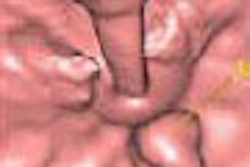
NEW YORK (Reuters Health), Nov 15 - The tissue-resonance interaction method (TRIM) for analyzing electromagnetic anisotropy can be used to detect prostate cancer noninvasively, according to a report in the November issue of BJU International.
"We have now a new technology for the diagnosis of prostate cancer," Dr. Luigi Da Pozzo from University Vita-Salute H San Raffaele, Milan, Italy, told Reuters Health. "This needs, in our opinion, to be used not as an alternative to PSA, DRE, and prostatic biopsies, but mainly in association with them to allow a more precise, less invasive, and less expensive diagnosis or exclusion of prostate cancer."
Dr. Da Pozzo and colleagues explain the physical principles of this technology in their paper: "Briefly, an alternating electromagnetic field interacts with charged particles in a target tissue and provokes a secondary radiation. Normal and neoplastic biological tissues interact with electromagnetic waves differently, and the detection and recording of specific changes in the level of electromagnetic fields that irradiate a target tissue can hypothetically be used in clinical practice to predict cancer."
The researchers assessed the diagnostic accuracy of TRIM, a device for analyzing electromagnetic anisotropy in biological tissues, in detecting prostate cancer compared with the results obtained from prostate biopsies in 188 men with elevated PSA levels or suspicious digital rectal examinations.
TRIM correctly detected 49 of 61 patients (80%) with prostate cancer while giving false-positive results in 62 of 127 patients (48%), the authors report.
Prostate cancer detection rates on biopsy were significantly higher in patients with a positive TRIM result (44%) than in patients with a negative TRIM result (15%), the report indicates.
"We still do not feel comfortable foregoing biopsy in patients who have an elevated PSA but a negative TRIM result," Dr. Da Pozzo said. "We do instead feel comfortable now to avoid a second series of prostatic biopsies in patients with a negative TRIM and an elevated PSA."
Dr. Da Pozzo added, "In order to increase specificity and the positive predictive value of this new technology (without, of course, decreasing sensitivity), we are trying to establish new criteria to define a positive or negative TRIM examination."
BJU Intl 2007;100:1055-1059.
By Will Boggs, M.D.
Last Updated: 2007-11-14 16:27:00 -0400 (Reuters Health)
Related Reading
Salvage cryotherapy safe, effective after radiation failure for prostate cancer, November 6, 2007
Copyright © 2007 Reuters Limited. All rights reserved. Republication or redistribution of Reuters content, including by framing or similar means, is expressly prohibited without the prior written consent of Reuters. Reuters shall not be liable for any errors or delays in the content, or for any actions taken in reliance thereon. Reuters and the Reuters sphere logo are registered trademarks and trademarks of the Reuters group of companies around the world.

















